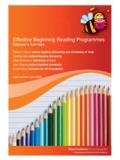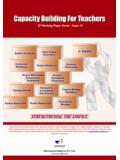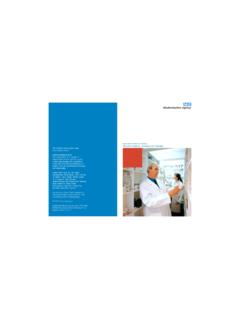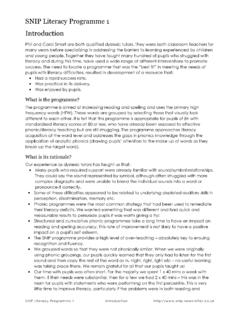Transcription of time in mainstream classes being taught by subject ...
1 Dyslexia in the Secondary School Improving whole school achievement through dyslexia aware best practice The creation of a dyslexia aware secondary school initially depends on a common understanding among all staff of what dyslexia is and how it manifests as a learning and teaching issue. A key issue is to arrive at a description of dyslexia that resonates with classroom practitioners. Presenting dyslexia as a specific learning difficulty is not helpful in secondary schools this often leads to it being seen as a problem which is the responsibility of someone with special training . Consequently during whole school training the writer always refers to dyslexia as a specific learning difference. subject specialists have related well to this, especially when challenged to identify students who have unexpected difficulties in reading and recording aspects of the subject in comparison to ability appropriate understanding of themes and concepts.
2 Now, as teachers strive to adopt new techniques such as personalised learning and assessment for learning, a new description dyslexia as a learning preference is beginning to have a significant impact internationally. The case for this paradigm shift is seductive and compelling; if dyslexia is a learning preference it means that there is nothing intrinsically wrong with the student as implied through terms such as specific learning difficulty or even disability. Instead student learning needs are defined by preferred ways to access, process and present knowledge, skills and concepts. Having delivered hundreds of hours of whole school dyslexia training to secondary schools in the UK and abroad the writer is very clear about one thing - experienced and pressured teachers do not value or appreciate training which focuses on identification through checklists and their responsibilities to a small group of dyslexic students with severe learning needs.
3 For better or for worse, what they do want is to know how to identify and respond effectively to individual learning needs within whole class settings in order to improve achievement and attainment. They also appreciate guidance on how to make use of readily available data that has been collected once and used lots . In other words they are looking for strategies and responses which fit seamlessly into current whole school imperatives based around monitoring, tracking and adding value though effective learning and teaching. This is not to marginalise the needs of severely dyslexic students; rather it is to acknowledge the current reality that most dyslexic students in secondary schools around the world spend most, if not all, of their time in mainstream classes being taught by subject specialists with little awareness of or interest in the reasons behind their specific learning needs. The final objective of effective whole school training is to support all staff to develop their dyslexia radar, not to label students but to identify those who will benefit from being taught as if they are dyslexic.
4 Getting it right means more needs met through Quality First teaching resulting in higher quality intervention being available for smaller numbers of students. Interestingly, one impact of effective whole school training is a definite interest in causation. It is as if effective training removes scales from the eyes of previously cynical teachers who, now they understand, somehow feel better able to notice dyslexic type learning needs and adjust their teaching accordingly, especially when they are shown how close best practice is to what they are currently doing. Indeed it is often the most suspicious teachers who end up as champions of their dyslexic students. So being dyslexic in a secondary school can be a rewarding experience; it can also be extremely uncomfortable. The determining factor seems to be the commitment and vision of the Senior Management Team (SMT) and experience shows that this may be even more important to the educational and emotional well being of dyslexic learners than a lead person with a specialist qualification.
5 The ideal scenario, of course, is to have the specialist backed by the senior management. However a specialist without support can only influence a small number of students whereas a strong management team communicates a message that all learners are important, institutes rigorous monitoring to identify stuck pupil, plans intervention to move them on and tracks to make sure the movement continues. This style of management embodies the principle of no learner left behind which is an appropriate mantra for an aspiring dyslexia aware secondary school. Effective whole school training offers directions for senior managers as well as subject teachers especially, with regard to criteria for lesson observations and performance management interviews and also the way subject /team leaders manage by walking about learning walks with clearly understood and communicated criteria for the observation of dyslexia aware best practice are very effective in identify and promoting desired learning and teaching outcomes.
6 The challenge is always to justify changing the way a school works on behalf of the 10% or so of learner s who are dyslexic to some degree. What about the rest? is a common refrain, especially from staff who feel it is their job to teach the syllabus, rather than secure learning. Appreciating this subtle distinction between teaching and learning is at the heart of developing a dyslexia aware school, a distinction which is very current in the UK in particular and also likely to be a major issues in countries like New Zealand, where a new National Curriculum has just been launched, and in Hong Kong where changes are being implemented to public examinations to include more dyslexic learners. Ironically it is the flawed UK national curriculum which is leading to exciting and intrinsically dyslexia aware developments as teachers struggle to come to terms with prescriptive syllabi, programmes of study which assume that all learners are ready to move to the next stage at the same time and an culture which places a premium on the acquisition and recall of knowledge rather than the development of skills.
7 Effective responses to pressures to deliver the undeliverable have included initiatives to personalise learning and to assess through and during learning as well as at the end of a sequence of instruction. Although these measures were not put in place with the needs of dyslexic learners in mind they both epitomise dyslexia aware best practice, offering significant opportunities to improve achievement and attainment. It is important at this time to distinguish between achievement and attainment; achievement is about a learner s journey from where they were to where they are now and can be measured by, for example, comparing work done in September with work done in March. The sample of work below is an example of student achievement in the form of a learning journey over a period of some seven months for a 12 year old learner. While there can be little doubt that this dyslexic student is achieving, actual attainment may be harder to measure, especially in terms of norm based results and/or the sorts of level descriptors that can typify a national curriculum approach.
8 In these contexts student performance is measured against either a large age related sample or an arbitrary statement about what should be achievable at a given age. Both contexts embody a traditional view of attainment and tend to discriminate against dyslexic students because few are traditional learners. Interviews with high achieving dyslexic adults tend to support this view Richard Branson is reported to have found school a nightmare before going on to found the Virgin group while Einstein s teachers apparently considered him to be mentally slow ! In consequence both highly successful individuals needed to get out of compulsory education in order to achieve their potential, something which is often still the case today, especially in schools which find it difficult to establish a culture in which achievement is valued as much as attainment. In reality the situation is not a black and white case of either attainment or achievement dyslexia aware schools acknowledge that facilitating achievement is the first step towards attainment, especially as success breeds success.
9 Students who work in a culture of achievement soon cast off the baggage of years of perceived failure to attain and, as self image and confidence improve, they begin to make progress against a variety of measures. This is one benefit that a dyslexia aware school brings to a wider range of students the measures that are put in place to ensure that no dyslexic student is left behind seem to improve the opportunities of students with a range of learning needs, including those with Attention Deficit/Hyperactivity Disorders (ADHD), Asperger s Syndrome and Dyspraxia/Developmental Coordinational Disorder. In the case of the writer s school, as dyslexia aware best practice became common practice, measurable improvements were recorded in a number of areas, including exam results, attendance and, evidenced by the number of new families choosing to move into the school catchment area, parental confidence. All too often teachers with management responsibilities for student progress find themselves trying to do everything for everybody, with inevitable compromises in terms of quality and efficiency.
10 On the other hand, the only way to eat an elephant is to take one bite at a time. Beginning with a focus on the achievement and attainment of dyslexic students offers a manageable opportunity to develop effective monitoring, tracking and response strategies within a clearly defined target group. Then, as confidence and expertise develop, the focus can be extended across a range of target learners perhaps more able and talented or those failing to make expected progress using techniques developed with dyslexic learners. Also, as schools drill down through the layers of data relating to dyslexic students and respond to findings, the seismic vibrations inevitably influence other groups. So, almost by default, a focus on one group can secure tangible benefits for all. Why then begin with dyslexic learners? Simply because they are the largest definable group of vulnerable students within any school and their learning needs respond to well to the types of fine tuning of lesson preparation, materials and delivery that represent the very best of current and future classroom practice.






